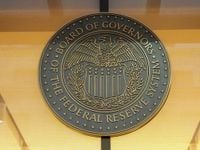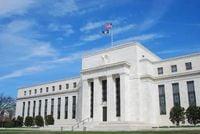The Federal Reserve made headlines on September 17, 2025, when it announced its first interest rate cut of the year, lowering its benchmark rate by a quarter of a percentage point to a range between 4% and 4.25%. This move, which had been widely anticipated by economists and market watchers alike, comes as the U.S. economy faces a slowing labor market, persistent inflation, and a swirl of political drama surrounding the central bank’s independence.
For months, President Donald Trump had publicly and privately pressured the Fed to lower rates, arguing that more aggressive action was necessary to revive a flagging jobs market. According to ABC News, the Federal Open Market Committee (FOMC) projected two additional quarter-point rate cuts over the remainder of 2025, though the size of Wednesday’s cut fell short of Trump’s more ambitious demands. In a press conference following the announcement, Fed Chair Jerome Powell acknowledged the difficult position facing policymakers. “It’s a challenging situation when our goals are in tension like this,” Powell said, referencing the Fed’s dual mandate to maximize employment and keep inflation in check. “Job gains have slowed and downside risks to employment have risen.”
The data backs up Powell’s concern. Job growth nearly ground to a halt over the summer, with employers adding an average of just 27,000 jobs per month from May through August—a dramatic slowdown compared to the 123,000 jobs per month added in the first four months of the year, as reported by Axios. Meanwhile, inflation has remained stubbornly high, with the Consumer Price Index climbing 2.9% year-over-year in August, up from 2.7% in July. The combination of tepid job creation and rising prices has led some economists to warn of “stagflation”—a rare and troubling mix of stagnant growth and inflationary pressure.
“Recent indicators suggest that growth of economic activity moderated in the first half of the year. Job gains have slowed, and the unemployment rate has edged up but remains low. Inflation has moved up and remains somewhat elevated,” the Fed said in its official statement on Wednesday. Powell elaborated further, telling reporters that the labor market is “really cooling off,” and attributing the slowdown in part to ongoing tariff and immigration policies. “A decline in both the supply and demand of workers is unusual,” he noted, underscoring the complexity of the current economic landscape.
The Fed’s decision wasn’t without controversy. Stephen Miran, a top White House economic advisor who was confirmed to the Fed’s Board of Governors just two days before the meeting, cast the lone dissenting vote. Miran argued for a steeper, half-point rate cut, saying the risks to employment warranted more aggressive action. “There wasn’t widespread support at all for a 50 basis point cut today,” Powell responded when asked about Miran’s position. “You tend to do that at a time when you feel policy needs to move quickly to a new place ... That’s not at all what I feel.”
Miran’s appointment—and his dissent—highlighted growing divisions within the central bank, as well as the intensifying political pressure from the Trump administration. The Senate confirmed Miran on September 15 by a narrow 48-47 vote, with only one Republican senator breaking ranks. Miran, who is taking an unpaid leave from his role as the White House’s top economist, pledged to safeguard the Fed’s independence, but his close ties to the administration have raised eyebrows. Senate Minority Leader Chuck Schumer called Miran “nothing more than Donald Trump’s mouthpiece at the Fed,” according to Reuters.
The political drama didn’t end there. Trump has also moved to remove Fed Governor Lisa Cook, a Biden appointee, over allegations of mortgage fraud—a charge Cook strongly denies. In a statement provided to ABC News, Cook said, “I have no intention of being bullied to step down from my position because of some questions raised in a tweet. I do intend to take any questions about my financial history seriously as a member of the Federal Reserve and so I am gathering the accurate information to answer any legitimate questions and provide the facts.” A federal appeals court blocked Trump’s attempt to oust Cook on September 15, allowing her to continue serving on the board while her case winds its way through the courts. The administration has vowed to appeal, setting up a potential showdown over the legal boundaries of presidential authority and central bank independence.
Despite these tensions, the Fed’s leadership has insisted on maintaining its autonomy. “The Fed remains strongly committed to maintaining our independence,” Powell said at Wednesday’s press conference, pointedly resisting the president’s calls for more drastic action. The central bank’s projections suggest a cautious approach: the median Fed official now anticipates two more quarter-point rate cuts in 2025 and only one additional cut in 2026—not the multiple percentage points worth of cuts that Trump has advocated. Other Trump-appointed board members, Christopher Waller and Michelle Bowman, supported the quarter-point cut, having previously dissented against holding rates steady.
Markets responded with a mix of relief and uncertainty. As Reuters reported, the S&P 500 dipped by 0.6%, the Nasdaq fell by 1%, and the Dow Jones Industrial Average rose by 0.4% in the hours following the announcement. Investors had largely priced in a 25 basis point cut, with the CME FedWatch tool putting the odds at 96% ahead of the meeting. Still, Powell’s somber tone about the economic outlook seemed to dampen any initial optimism.
The Fed’s updated economic projections, released for the first time since May, showed only modest changes. The median official sees GDP growth of 1.6% for 2025, up slightly from 1.4% in June. The unemployment rate projection remained unchanged at 4.5%, while inflation is expected to hover around 3%. The central bank also reiterated its openness to further rate cuts “as appropriate if risks emerge” that could threaten its dual mandate of maximum employment and stable prices.
All the while, the White House is already looking ahead. Treasury Secretary Scott Bessent is reportedly interviewing candidates to replace Powell when his term expires in May. The outcome of that search—and the ongoing legal battles over Fed board appointments—could shape the central bank’s direction for years to come.
As the dust settles from this week’s decision, one thing is clear: the Federal Reserve is navigating one of the most politically charged and economically uncertain environments in its 112-year history. Whether its cautious approach will be enough to steer the U.S. economy through these choppy waters remains to be seen, but the stakes could hardly be higher.


